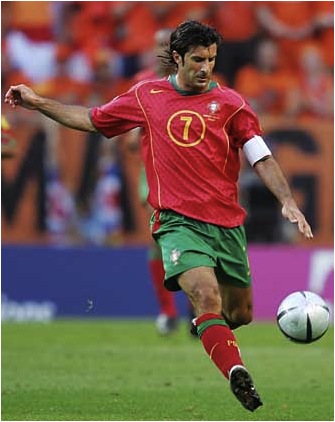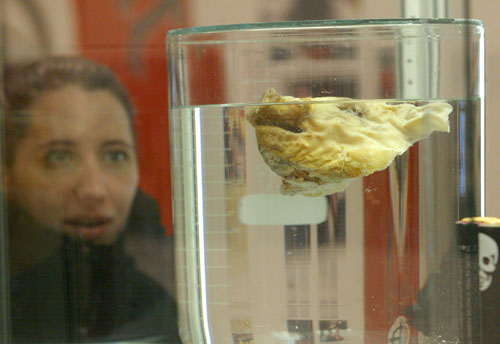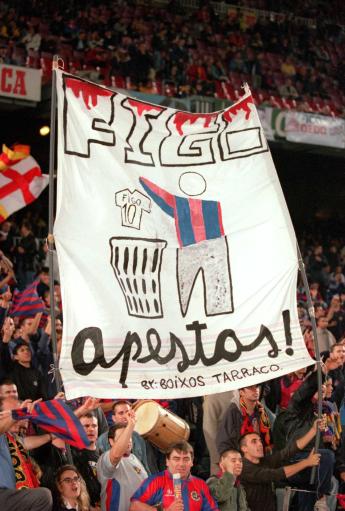Luís Figo as Catalyst
Luís Figo is an enduring icon in Portuguese football. As a member of the “golden generation” that won U-20 World Youth Championships in 1989 and 1991, he had always been marked for greatness[i]. He succeeded in winning European Footballer of the Year in 2000, FIFA World Footballer of the Year in 2001, and six consecutive Portuguese Footballer of the Year awards from 1995-2000[ii]. Finally, Figo extended his legacy by becoming the only member of his storied generation to extend his career in order to compete on the 2006 World Cup team, which he captained to a semi-final defeat to France. Yet, as much as Figo has done for Portuguese football, he has arguable done even more to fuel the rivalry between FC Barcelona and Real Madrid.
Luís Figo, though playing for Barça for only a short time, was an adored cult hero, and “an icon of barcelonismo.”[iii] Maturing under the colors of Catalonia, he became one the worlds greatest footballers while playing for FC Barcelona. Despite his Portuguese heritage, and the fact that FC Barcelona had bought him only a few years earlier after a dispute between Italian clubs Juventus and Parma made him available, Figo had been intrinsically woven into the identity of the Barcelona team, as defined, and promulgated, by their fans (particularly Barca’s Ultras, the Boixos Nois). In July 2000, Barcelona fans were devastated to hear that Figo had been bought for a then-world-record fee of $56 million,[iv] When they learned who he was bought by, archrival Real Madrid, devastation turned to seething anger, the depths of which soccer has rarely known. Figo’s move to FC Barça’s mortal enemy constituted, “a special type of transgression of player-club loyalty,”[v] one which could, and would, never be forgiven.
Figo would make his first appearance back in Camp Nou, now playing for the opposition, three months after his transfer, on October 22, 2000. The headline of Marca, a leading football periodical in Barcelona published a picture of Figo’s ear, with the headline, “Figo: Te Van a calentar la oreja (Figo, they’re going to make your ears burn).”[vi] Which is precisely what they did, asthe fans abused him so loudly on every corner kick that his performance ultimately suffered. However this would be just a preview of what was to come, as the Catalonians’s anger would not subside, and only grew with time
Over two years after his ignominious transfer, in November 2002, during the “ ‘Derbi de la Vergüenza’ (Derby of Shame),”[vii] Figo was met by an even angrier crowd. During this match, when Figo went to take a corner kick, the Boxois Nois, a neo-fascist ultra fan group[viii], threw “the head of a suckling pig and a full bottle of whisky”[ix] at him.

The preserved pig’s head was later featured in a museum exhibit cataloging Barcelona soccer memorabilia, titled ‘Pasión en las gradas’ (Passion in the Stands) in 2008, showing that the anger at his move had not subsided[x].
Luís Figo became an accelerant, and his move elevated the fiery rivalry between FC Barcelona and Real Madrid to new heights of enmity. That this Portuguese legend serves as the crux of contention between two fervently regionalist clubs of neighboring Spain is a testament to the new notions of player loyalty in the modern epoch of football. History will remember Figo through what he has come to mean to a multitude of different peoples. To the fans of Real Madrid, Figo was an integral transfer, who helped them to achieve continued success and marked the start of the galácticos era in which Madrid won the Champions League and two La Liga titles. To the nation of Portugal, Figo is a national hero, and arguably their greatest footballer of all time. Yet for the fans for FC Barcelona, whose motto is fittingly, “més que un club” (More than a club), Figo will always be a traitor.
To continue to Why El Clásico Matters, click here.
To return to the main page, click here.
How to cite this article: “El Clásico as Spanish History,” Written by Austin Esecson, Remy Lupica, and Neel Muthana (2009), Edited and Updated by Austin Ness, Vishnu Kadiyala, Natasha Catrakilis, Julianna Miller, and Basil Seif (2013), Soccer Politics Pages, Soccer Politics Blog, Duke University, http://sites.duke.edu/wcwp/research-projects/spain/ (accessed on (date)).
– See more at: http://sites.duke.edu/wcwp/research-projects/spain/#sthash.ZqurdBvV.dpuf
[i] Witzig, Richard. The global art of soccer. New Orleans: CusiBoy Publishing, 2006. p. 311
[ii] Witzig, Richard. The global art of soccer, p. 164
[iii] Castillo, Juan Carlos. “The concept of loyalty and the challenge of internationalization in post-modern Spanish Football.” International Journal of Iberian Studies 20.1 (2007): 23-40, p. 33
[iv] Hughes, Rob. “Soccer: The light fades for the darkest galactico.” The New York Times 3 August 2005. Online.
[v] Castillo, Juan Carlos. “The concept of loyalty…. “ p. 33
[vi] Ball, Morbo, 18
[vii] Ibid
[viii] Goldblatt, David. The Ball is Round: A Global History of Soccer. New York: Penguin Books, 2008. p. 727
[ix] Ball, Morbo, 19
[x] Moreno, Antonio. “Pasión en las gradas.” elmundo.es 17 January 2008. Online.





Pingback: What Makes Barcelona and Real Madrid ‘El Clasico’ the Greatest Rivalry in Sport ? « Sports Greatest Rivalries
Pingback: What Makes Barcelona and Real Madrid ‘El Clasico’ the Greatest Rivalry in Sport? « Sports Greatest Rivalries